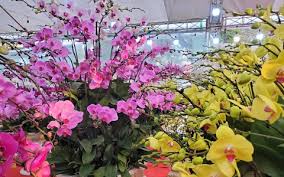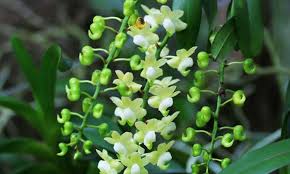
Phalaenopsis orchids, commonly known as moth orchids, have captivated artists and photographers for centuries with their exquisite beauty, vibrant colors, and elegant forms. These flowers not only symbolize luxury and beauty but also evoke feelings of tranquility and serenity. This article explores the significant role of Phalaenopsis orchids in both painting and photography, examining their historical representations, symbolism, and the artistic techniques used to capture their essence.
## 1. The Allure of Phalaenopsis Orchids
### 1.1. Overview of Phalaenopsis Orchids
Phalaenopsis orchids are characterized by their broad, flat petals and long-lasting blooms. They are native to Southeast Asia and have become one of the most popular orchids in the world due to their stunning visual appeal and ease of care. Their diverse colors and patterns make them a favorite subject in various artistic expressions.
### 1.2. Symbolism of Orchids in Art
Orchids have long been associated with luxury, beauty, and strength. In many cultures, they symbolize love, refinement, and exoticism. The delicate nature of Phalaenopsis orchids has made them a popular choice in art, symbolizing the fleeting nature of beauty and the importance of appreciating life’s moments.
## 2. Phalaenopsis Orchids in Painting
### 2.1. Historical Context
Throughout history, orchids have been featured in various art movements. From traditional Chinese and Japanese paintings to the vibrant floral compositions of the Impressionists, Phalaenopsis orchids have left a significant mark.
### 2.2. Traditional Paintings
#### 2.2.1. Chinese and Japanese Art
In traditional Chinese art, orchids symbolize refinement and integrity. Artists would often depict orchids in delicate brush strokes, capturing their grace and beauty. Japanese Ukiyo-e prints frequently featured floral themes, with orchids represented as symbols of beauty and transience.
#### 2.2.2. European Still Life
During the 17th and 18th centuries, European artists began to incorporate exotic flowers like orchids into still life paintings. Artists such as Jan Davidsz de Heem and Ambrosius Bosschaert created stunning compositions that showcased the beauty and intricacy of these flowers, often pairing them with other botanical elements.
### 2.3. Modern Interpretations
In contemporary art, Phalaenopsis orchids continue to inspire artists. Many modern painters use bold colors and abstract forms to represent the essence of orchids. The juxtaposition of traditional techniques with modern interpretations allows for a fresh perspective on these timeless flowers.
#### 2.3.1. Abstract Art
Artists like Georgia O’Keeffe and Takashi Murakami have reimagined orchids through abstract lenses, focusing on their shapes and colors rather than realistic representations. O’Keeffe’s large-scale floral paintings often convey the emotional resonance of flowers, while Murakami blends traditional Japanese motifs with modern pop art aesthetics.
#### 2.3.2. Mixed Media
Mixed media artists have also embraced Phalaenopsis orchids, using various materials to create textured and dynamic representations. By combining paint, fabric, and found objects, artists can express the multifaceted beauty of orchids, capturing their fragility and strength.
## 3. Phalaenopsis Orchids in Photography
### 3.1. The Evolution of Botanical Photography
Botanical photography emerged in the 19th century as a way to document and study plants. Phalaenopsis orchids quickly became popular subjects due to their unique forms and vibrant colors. Early photographers, such as Anna Atkins, used cyanotype techniques to capture the beauty of flowers, laying the groundwork for future botanical photography.
### 3.2. Techniques for Capturing Orchids
Photographers utilize various techniques to capture the beauty of Phalaenopsis orchids. Understanding lighting, composition, and focus is crucial for creating stunning images.
#### 3.2.1. Lighting
Lighting plays a vital role in photography, particularly when capturing the delicate petals of orchids. Natural light is often preferred for its ability to highlight the intricacies of the flowers. Photographers can experiment with different times of day, such as early morning or late afternoon, to achieve the best results.
#### 3.2.2. Composition
Composition refers to how elements are arranged within a photograph. Photographers can enhance the visual impact of their images by employing techniques such as the rule of thirds, leading lines, and framing. Experimenting with angles and perspectives can also create unique interpretations of Phalaenopsis orchids.
#### 3.2.3. Macro Photography
Macro photography allows photographers to capture the intricate details of Phalaenopsis orchids, revealing patterns and textures that may go unnoticed. This technique involves using specialized lenses to achieve close-up shots, emphasizing the beauty of each bloom.
### 3.3. Contemporary Botanical Photography
Contemporary photographers continue to explore the beauty of Phalaenopsis orchids, often using innovative techniques to push the boundaries of traditional botanical photography. Artists like Robert Mapplethorpe and Andreas Gursky have gained recognition for their striking images of flowers, elevating botanical photography to a fine art form.
#### 3.3.1. Conceptual Photography
Conceptual photography involves creating images that convey ideas or emotions rather than just depicting objects. Photographers can use Phalaenopsis orchids to explore themes such as fragility, impermanence, and beauty. By placing orchids in unconventional settings or juxtaposing them with contrasting elements, photographers can evoke deeper meanings and provoke thought.
#### 3.3.2. Digital Manipulation
With the advent of digital technology, photographers can manipulate images in ways previously unimaginable. Techniques such as layering, color adjustments, and digital painting allow artists to create surreal and dreamlike representations of Phalaenopsis orchids. This approach challenges traditional notions of beauty and invites viewers to see flowers in a new light.
## 4. The Intersection of Art and Photography
### 4.1. Blurring Boundaries
As the lines between painting and photography continue to blur, artists and photographers are increasingly inspired by one another. Many contemporary artists draw upon photographic techniques in their paintings, while photographers may incorporate painting elements into their work.
### 4.2. Collaboration
Collaborative projects between painters and photographers can result in unique interpretations of Phalaenopsis orchids. Such collaborations can challenge conventions, leading to innovative and thought-provoking works of art.
### 4.3. Exhibitions and Installations
Art exhibitions featuring Phalaenopsis orchids often showcase both paintings and photographs, highlighting the diverse ways artists interpret these beautiful flowers. Installations that combine live orchids with artistic representations can create immersive experiences for viewers, engaging multiple senses.
## 5. The Impact of Phalaenopsis Orchids on Culture
### 5.1. Orchids in Literature and Poetry
Phalaenopsis orchids have also found their way into literature and poetry, symbolizing beauty, transience, and the natural world. Writers often use flowers as metaphors for emotions, relationships, and the passage of time.
### 5.2. Cultural Significance
In many cultures, orchids hold significant meanings. In Chinese culture, they symbolize refinement and beauty, while in Western cultures, they often represent luxury and elegance. This cultural significance extends to their portrayal in art, further enriching their representation in creative expressions.
## 6. Caring for Phalaenopsis Orchids for Artistry
### 6.1. Cultivating Orchids for Artists and Photographers
Artists and photographers may choose to cultivate their own Phalaenopsis orchids for inspiration. Proper care ensures healthy blooms, providing a continuous source of creativity.
### 6.2. Best Practices
#### 6.2.1. Light and Watering
Phalaenopsis orchids thrive in bright, indirect light. Watering should be done when the potting medium dries out, usually every 7-10 days. Proper humidity levels, typically between 50% to 70%, should be maintained to ensure healthy growth.
#### 6.2.2. Fertilization and Repotting
Regular fertilization during the growing season will promote healthy blooms. Repotting every one to two years helps refresh the potting medium and encourages growth.
## 7. The Future of Phalaenopsis Orchids in Art
### 7.1. Trends in Artistic Representation
As environmental awareness increases, artists are exploring themes of sustainability and conservation through their representations of Phalaenopsis orchids. This trend encourages viewers to reflect on the relationship between humans and nature.
### 7.2. Technology and Innovation
Advancements in technology, such as augmented reality and virtual reality, may provide new platforms for artists to showcase their work. These innovations could create immersive experiences that allow viewers to engage with Phalaenopsis orchids in novel ways.
### 7.3. Global Collaboration
Artists worldwide are collaborating to create cross-cultural representations of orchids, reflecting diverse perspectives and traditions. This global exchange fosters creativity and encourages a deeper understanding of the beauty and significance of Phalaenopsis orchids.
## 8. Conclusion
Phalaenopsis orchids occupy a cherished place in the realms of painting and photography, serving as powerful symbols of beauty, elegance, and transience. Their allure continues to inspire artists and photographers alike, prompting them to explore innovative techniques and interpretations. As we appreciate the intricate details and delicate forms of these stunning flowers, we are reminded of the importance of creativity and the profound connections between art, nature, and humanity. Whether captured on canvas or film, Phalaenopsis orchids will undoubtedly continue to thrive as subjects of artistic exploration for generations to come.


